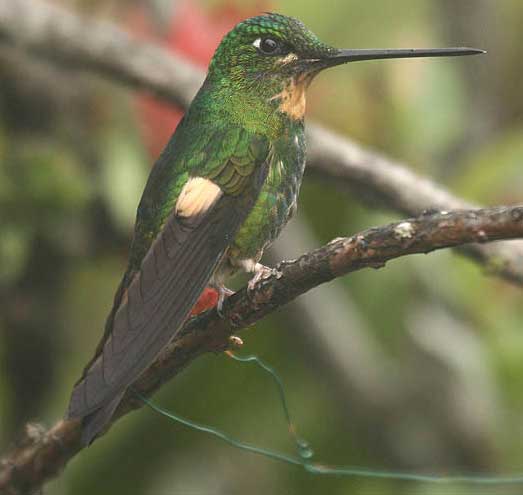
Coeligena lutetiae (*)
Superregnum: Eukaryota
Cladus: Unikonta
Cladus: Opisthokonta
Cladus: Holozoa
Regnum: Animalia
Subregnum: Eumetazoa
Cladus: Bilateria
Cladus: Nephrozoa
Superphylum: Deuterostomia
Phylum: Chordata
Subphylum: Vertebrata
Infraphylum: Gnathostomata
Megaclassis: Osteichthyes
Cladus: Sarcopterygii
Cladus: Rhipidistia
Cladus: Tetrapodomorpha
Cladus: Eotetrapodiformes
Cladus: Elpistostegalia
Superclassis: Tetrapoda
Cladus: Reptiliomorpha
Cladus: Amniota
Classis: Reptilia
Cladus: Eureptilia
Cladus: Romeriida
Subclassis: Diapsida
Cladus: Sauria
Infraclassis: Archosauromorpha
Cladus: Crurotarsi
Divisio: Archosauria
Cladus: Avemetatarsalia
Cladus: Ornithodira
Subtaxon: Dinosauromorpha
Cladus: Dinosauriformes
Cladus: Dracohors
Cladus: Dinosauria
Ordo: Saurischia
Cladus: Eusaurischia
Subordo: Theropoda
Cladus: Neotheropoda
Cladus: Averostra
Cladus: Tetanurae
Cladus: Avetheropoda
Cladus: Coelurosauria
Cladus: Tyrannoraptora
Cladus: Maniraptoromorpha
Cladus: Maniraptoriformes
Cladus: Maniraptora
Cladus: Pennaraptora
Cladus: Paraves
Cladus: Eumaniraptora
Cladus: Avialae
Infraclassis: Aves
Cladus: Euavialae
Cladus: Avebrevicauda
Cladus: Pygostylia
Cladus: Ornithothoraces
Cladus: Ornithuromorpha
Cladus: Carinatae
Parvclassis: Neornithes
Cohors: Neognathae
Cladus: Neoaves
Superordo: Caprimulgimorphae
Ordo: Apodiformes
Familia: Trochilidae
Subfamilia: Trochilinae
Genus: Coeligena
Species: Coeligena lutetiae
Name
Coeligena lutetiae (DeLattre & Bourcier, 1846)
References
Rev.Zool. 9 p.307
Vernacular names
English: Buff-winged Starfrontlet
magyar: Fakószárnyú csillagoskolibri
The buff-winged starfrontlet (Coeligena lutetiae) is a species of hummingbird in the "brilliants", tribe Heliantheini in subfamily Lesbiinae. It is found in Colombia, Ecuador, and Peru.[3][4]
Taxonomy and systematics
The buff-winged starfrontlet and most other members of genus Coeligena were at one time placed in genus Helianthea but have been in their current placement since the mid-1900s.[5] The International Ornithological Committee (IOC) and BirdLife International's Handbook of the Birds of the World (HBW) recognize two subspecies, the nominate C. l. lutetiae and C. l. albimaculata.[3][4] However, the Clements taxonomy treats the species as monotypic.[6]
Description
A female, Yanacocha Reserve, Ecuador
The buff-winged starfrontlet is about 14 cm (5.5 in) long. Males weigh 6.9 to 7.2 g (0.24 to 0.25 oz) and females about 6.6 g (0.23 oz). Both sexes have a long, black, slightly upturned bill and a white spot behind the eye. Both sexes have a forked tail though the female's is not as deeply indented as the male's. Males of the nominate subspecies has velvety black upperparts with a glittering green forehead. They have a violet gorget and the rest of the underparts are dark green. The wings are dark with a large cinnamon-buff patch and the tail is bronzy black. Nominate females have shining dark green upperparts. Their throat is cinnamon-buff and the rest of the underparts golden green with pale fringes on the feathers. They have the same cinnamon-buff wing patch as the males but the tail is bronzy green.[7]
Males of subspecies C. l. albimaculata have almost white wing patches but are otherwise like the nominate. Females have a paler throat than the nominate and a cinnamon tinge to the underparts, whose golden green is also less iridescent.[7]
Distribution and habitat
The nominate subspecies of buff-winged starfrontlet is found from the Central Andes of Colombia south through the Andes of Ecuador into far northern Peru. C. l. albimaculata is found only in northwestern Ecuador. The species inhabits cloudforest, elfin forest, and the lower edges of páramo. In elevation it ranges from 2,600 to 4,800 m (8,500 to 15,700 ft) but is most common around 3,000 m (9,800 ft).[3][7]
Behavior
Movement
The buff-winged starfrontlet is generall sedentary, though some movement to follow flowering plants has been noted.[7]
Feeding
The buff-winged starfrontlet feeds on nectar by trap-lining, visiting a circuit of flowering plants, but it also will defend patches of flowers. It most often forages at low levels at the margins of forest, and often clings to flowers to feed as well as hovering. In addition to feeding on nectar it captures small arthropods by gleaning from foliage and by hawking.[7]
Breeding
The buff-winged starfrontlet's breeding season in Colombia is August and September; it is not defined elsewhere. It builds a cup nest in a branch fork, typically about 2 to 4 m (7 to 13 ft) above ground. The female incubates the clutch of two eggs for 15 to 17 days; the time to fledging has not been determined.[7]
Dickcissel male perched on a metal pole singing, with neck stretched and beak open.
Songs and calls
Listen to buff-winged starfrontlet on xeno-canto
Vocalization
The buff-winged starfrontlet makes a "thin, wiry chatter with rattles", often during territorial disputes. While feeding it often repeats "a characteristic, nasal 'unk'".[7]
Status
The IUCN has assessed the buff-winged starfrontlet as being of Least Concern, though its population size is not known and is believed to be decreasing.[1] Though it has a fairly large overall range, its habitat is patchy, fragmented, and under continuing threat of deforestation. It is not thought likely to accept human-made habitats like gardens.[7]
References
BirdLife International (2016). "Buff-winged Starfrontlet Coeligena lutetiae". IUCN Red List of Threatened Species. 2016: e.T22687837A93171600. doi:10.2305/IUCN.UK.2016-3.RLTS.T22687837A93171600.en. Retrieved 2 May 2022.
"Appendices | CITES". cites.org. Retrieved 2022-01-14.
Gill, F.; Donsker, D.; Rasmussen, P. (July 2021). "IOC World Bird List (v 12.1)". doi:10.14344/IOC.ML.11.2. Retrieved 15 January 2022.
HBW and BirdLife International (2020) Handbook of the Birds of the World and BirdLife International digital checklist of the birds of the world Version 5. Available at: http://datazone.birdlife.org/userfiles/file/Species/Taxonomy/HBW-BirdLife_Checklist_v5_Dec20.zip [.xls zipped 1 MB] retrieved 27 May 2021
Remsen, J. V., Jr., J. I. Areta, E. Bonaccorso, S. Claramunt, A. Jaramillo, D. F. Lane, J. F. Pacheco, M. B. Robbins, F. G. Stiles, and K. J. Zimmer. Version 31 January 2022. A classification of the bird species of South America. American Ornithological Society. https://www.museum.lsu.edu/~Remsen/SACCBaseline.htm retrieved February 1, 2022
Clements, J. F., T. S. Schulenberg, M. J. Iliff, S. M. Billerman, T. A. Fredericks, J. A. Gerbracht, D. Lepage, B. L. Sullivan, and C. L. Wood. 2021. The eBird/Clements checklist of Birds of the World: v2021. Downloaded from https://www.birds.cornell.edu/clementschecklist/download/ Retrieved August 25, 2021
Züchner, T., P. F. D. Boesman, and G. M. Kirwan (2020). Buff-winged Starfrontlet (Coeligena lutetiae), version 1.0. In Birds of the World (J. del Hoyo, A. Elliott, J. Sargatal, D. A. Christie, and E. de Juana, Editors). Cornell Lab of Ornithology, Ithaca, NY, USA. https://doi.org/10.2173/bow.buwsta1.01 retrieved 2 May 2022
Retrieved from "http://en.wikipedia.org/"
All text is available under the terms of the GNU Free Documentation License

